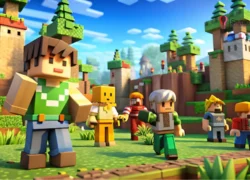With over 3.5 billion gamers worldwide and thousands of new games launched annually, one question remains constant: how long does it really take to develop a game?
One of the first questions we hear from clients at StudioKrew – Game Development Studio is:
“How long will it take to develop our game?”
The answer depends on several factors, including game type, features, platform, and team size. Game development is a flexible process, and depending on the scope and Complexity, it can take a few weeks to over a year. This flexibility allows us to adapt to your specific needs and requirements.
Let’s break down what goes into a game development timeline in 2025.
Average Time to Develop a Game (By Complexity)
| Game Type | Estimated Timeline |
|---|---|
| 2D Hyper-Casual Game | 4–8 weeks |
| Casual Mobile Game (with backend) | 2–4 months |
| 3D Mid-Core Game (Multiplayer or PvP) | 5–8 months |
| Real Money Game / MMO / Blockchain | 6–12+ months |
For example, we developed a hyper-casual AR game ‘Party Blaster’ in just 6 weeks as a MVP using Swift, ARKit, and Tensorflow.
If you’re unsure where your concept fits, partnering with a Custom Game Development Company can help you plan and phase your idea effectively.
Game Development Timeline – 6 Key Phases
Here’s a typical, predictable timeline based on how we build games at StudioKrew. This predictability ensures that you can plan and execute your project with confidence.
1. Discovery & Game Design (1–3 weeks)
- Game design document (GDD)
- Technical requirement gathering (SRS)
- Platform planning, monetization model
- Wireframes & gameplay mechanics
2. Art & UI/UX Design (2–5 weeks)
- Concept art, characters, environment
- UI/UX layout and feedback loops
- Asset creation and animation planning
3. Prototyping & Core Development (4–12 weeks)
- Engine setup (Unity / Unreal)
- Core game mechanics, level systems
- Backend architecture (Node.js, Firebase, Redis)
4. Multiplayer / Integrations / Smart Contracts (Optional, 2–6 weeks)
- Photon Fusion / WebSocket multiplayer setup
- Wallet & blockchain integration
- Payment systems, analytics, ad engines
5. Testing & Optimization (2–4 weeks)
- Internal QA + device testing
- Crash reports, bug fixing, playtesting
- A/B test gameplay loops and UI elements
6. Launch + LiveOps Setup (1–3 weeks)
- App store submission, compliance
- Analytics dashboards, retention tools
- Content pipeline for LiveOps / future updates
Pro Tip from StudioKrew’s Lead Dev:
“To reduce development time, define your MVP early. Build core mechanics, then scale based on player feedback and monetization data.”
What Slows Game Development Down?
- Scope creep or unclear vision
- Poor documentation (GDD/SRS)
- Asset overload (complex 3D animations)
- Lack of test-driven sprints or milestone reviews
- No LiveOps or post-launch roadmap
At StudioKrew, we address this challenge by utilizing Agile sprints, conducting bi-weekly demos, and implementing milestone-based planning with complete transparency. These practices enable us to adapt to changes, regularly showcase our progress, and ensure everyone is aligned, resulting in more efficient development. A key strategy for keeping your game relevant and scalable after launch is integrating Game LiveOps Services into your roadmap from the beginning.
Want to Build a Game with a Defined Timeline?
We help startups, enterprises, and indie creators scope, schedule, and launch games across mobile, web, and console platforms.
👉 Planning a game? Book a free consultation with our StudioKrew team to define your timeline and get expert advice on cost and scope. Let’s Connect





